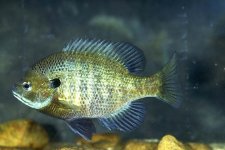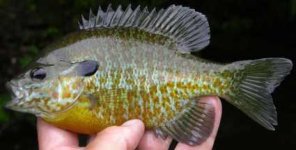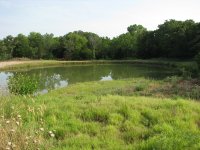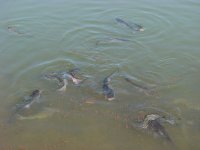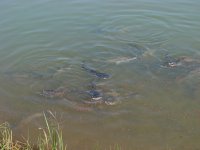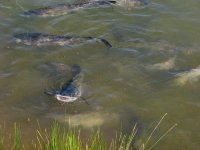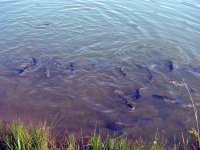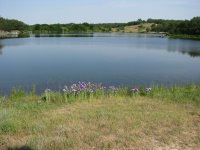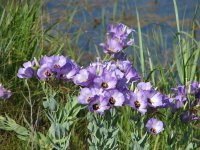To be honest Jim, it's unlikely that most people could tell the difference between coppernose and hybrids when they're 2-3 inches long. I suspect you got your fish from Dunn's fish truck or someone similar, and they'll sell you what they have. As with your butcher, you need someone you can trust.
If you can get your hands on some of the ones you stocked, you could look for the following identifying characteristics. Please check out the pics too.
Bluegill have vertical dark bars made up of individual flecks of pigment. In older fish these are always dark, as in black, but in younger fish they may be lighter. Generally there are a half dozen vertical bars or so on the main body of the fish. Also there is a dark cloud of pigmented dots on the back quarter of the dorsal fin (the long one on top). They also have a smaller mouth than a hybrid
Hybrids are generally an amalgam of green sunfish and bluegill characteristics. Most notably they don't have the same color vertical bars, and generally there are more of them. They also have turquoise integrated into their coloration which is most obvious on the head, with uneven lines under the eyes. Their mouth is bigger. When viewed from the side, the corner of their mouth is a lot closer to front of the eye than the tip of their nose. Imagine a vertical line running down from their eye and intersecting the horizontal plane of the mouth. The distance between the corner of the mouth and the intersection of those two lines is what I'm talking about.
A green sunfish picture is also attached. Note the even bigger mouth, which extends back under the eye.
The problem with hybrids is that their spawn tend to revert back to green sunfish, and they aren't as prolific. Also, they compete directly with young bass, as their larger mouth allows them to eat similar prey items, such as small fish. Green sunfish are even worse. That is not to say that each can't exist in a well-managed pond, it's just that they are a bad choice for a sole forage species.
As for stocking bass, I'd recommend no more than 50/acre and I'd put them in this fall at 4"-6". Putting them in when first available in June means small fish, which are more vulnerable to all sorts of things, including your hungry hybrid bluegill

If you want faster growth and larger fish, 25 per acre would be the lowest I'd go. As I recall, your pond is between 1 and 2 acres, so 50 bass would do you nicely. Don't pay extra for Florida, F1, or tiger (tigre) bass unless you get them from a trusted source. In such a small pond, the benefits from the Florida genetics will be minor without intensive management.
There you go, more than you wanted to know, I'm sure

